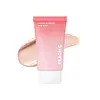What's inside
What's inside
 Key Ingredients
Key Ingredients

 Benefits
Benefits

 Concerns
Concerns

No concerns
 Ingredients Side-by-side
Ingredients Side-by-side

Water
Skin ConditioningZinc Oxide
Cosmetic ColorantCyclopentasiloxane
EmollientTitanium Dioxide
Cosmetic ColorantCoco-Caprylate/Caprate
EmollientCyclohexasiloxane
EmollientPEG-9 Polydimethylsiloxyethyl Dimethicone
EmulsifyingPolypropanediol-4
EmulsifyingNiacinamide
SmoothingSilica
AbrasiveIsododecane
EmollientCaprylyl Methicone
Skin ConditioningDisteardimonium Hectorite
StabilisingButyloctyl Salicylate
Skin ConditioningDiphenylsiloxy Phenyl Trimethicone
Skin ConditioningAluminum Hydroxide Oxide
AntimicrobialStearic Acid
CleansingAcrylates/Polytrimethylsiloxymethacrylate Copolymer
Skin ConditioningMagnesium Sulfate
Cetyl PEG/PPG-10/1 Dimethicone
EmulsifyingLauryl Polyglyceryl-3 Polydimethylsiloxyethyl Dimethicone
Skin ConditioningTriethoxycaprylylsilane
C30-45 Alkyl Cetearyl Dimethicone Crosspolymer
EmollientCaprylyl Glycol
EmollientGlyceryl Caprylate
EmollientDicaprylyl Carbonate
EmollientPolyurethane-1
Ethylhexylglycerin
Skin Conditioning1,2-Hexanediol
Skin ConditioningPrunus Persica Flower Extract
MoisturisingTocopherol
AntioxidantMaltodextrin
AbsorbentPentaerythrityl Tetra-Di-T-Butyl Hydroxyhydrocinnamate
AntioxidantSodium Citrate
BufferingCitric Acid
BufferingCyanocobalamin
Skin ConditioningCI 77491
Cosmetic ColorantCI 77492
Cosmetic ColorantParfum
MaskingWater, Zinc Oxide, Cyclopentasiloxane, Titanium Dioxide, Coco-Caprylate/Caprate, Cyclohexasiloxane, PEG-9 Polydimethylsiloxyethyl Dimethicone, Polypropanediol-4, Niacinamide, Silica, Isododecane, Caprylyl Methicone, Disteardimonium Hectorite, Butyloctyl Salicylate, Diphenylsiloxy Phenyl Trimethicone, Aluminum Hydroxide Oxide, Stearic Acid, Acrylates/Polytrimethylsiloxymethacrylate Copolymer, Magnesium Sulfate, Cetyl PEG/PPG-10/1 Dimethicone, Lauryl Polyglyceryl-3 Polydimethylsiloxyethyl Dimethicone, Triethoxycaprylylsilane, C30-45 Alkyl Cetearyl Dimethicone Crosspolymer, Caprylyl Glycol, Glyceryl Caprylate, Dicaprylyl Carbonate, Polyurethane-1, Ethylhexylglycerin, 1,2-Hexanediol, Prunus Persica Flower Extract, Tocopherol, Maltodextrin, Pentaerythrityl Tetra-Di-T-Butyl Hydroxyhydrocinnamate, Sodium Citrate, Citric Acid, Cyanocobalamin, CI 77491, CI 77492, Parfum
Water
Skin ConditioningGlycerin
HumectantButylene Glycol
HumectantGlycereth-26
Humectant1,2-Hexanediol
Skin ConditioningNiacinamide
SmoothingCamellia Sinensis Seed Oil
HumectantMethylpropanediol
SolventPanthenol
Skin ConditioningChlorella Vulgaris Extract
Skin ConditioningGlucose
HumectantAcrylates/C10-30 Alkyl Acrylate Crosspolymer
Emulsion StabilisingFructooligosaccharides
HumectantFructose
HumectantHydrogenated Lecithin
EmulsifyingSodium Polyacryloyldimethyl Taurate
Emulsion StabilisingYeast Ferment Extract
Skin ConditioningTromethamine
BufferingDipotassium Glycyrrhizate
HumectantEthylhexylglycerin
Skin ConditioningSodium Phytate
Candida Bombicola/Glucose/Methyl Rapeseedate Ferment
AntimicrobialTocopherol
AntioxidantWater, Glycerin, Butylene Glycol, Glycereth-26, 1,2-Hexanediol, Niacinamide, Camellia Sinensis Seed Oil, Methylpropanediol, Panthenol, Chlorella Vulgaris Extract, Glucose, Acrylates/C10-30 Alkyl Acrylate Crosspolymer, Fructooligosaccharides, Fructose, Hydrogenated Lecithin, Sodium Polyacryloyldimethyl Taurate, Yeast Ferment Extract, Tromethamine, Dipotassium Glycyrrhizate, Ethylhexylglycerin, Sodium Phytate, Candida Bombicola/Glucose/Methyl Rapeseedate Ferment, Tocopherol
 Reviews
Reviews

Ingredients Explained
These ingredients are found in both products.
Ingredients higher up in an ingredient list are typically present in a larger amount.
1,2-Hexanediol is a synthetic liquid and another multi-functional powerhouse.
It is a:
- Humectant, drawing moisture into the skin
- Emollient, helping to soften skin
- Solvent, dispersing and stabilizing formulas
- Preservative booster, enhancing the antimicrobial activity of other preservatives
Ethylhexylglycerin (we can't pronounce this either) is commonly used as a preservative and skin softener. It is derived from glyceryl.
You might see Ethylhexylglycerin often paired with other preservatives such as phenoxyethanol. Ethylhexylglycerin has been found to increase the effectiveness of these other preservatives.
Niacinamide is a multitasking form of vitamin B3 that strengthens the skin barrier, reduces pores and dark spots, regulates oil, and improves signs of aging.
And the best part? It's gentle and well-tolerated by most skin types, including sensitive and reactive skin.
You might have heard of "niacin flush", or the reddening of skin that causes itchiness. Niacinamide has not been found to cause this.
In very rare cases, some individuals may not be able to tolerate niacinamide at all or experience an allergic reaction to it.
If you are experiencing flaking, irritation, and dryness with this ingredient, be sure to double check all your products as this ingredient can be found in all categories of skincare.
When incorporating niacinamide into your routine, look out for concentration amounts. Typically, 5% niacinamide provides benefits such as fading dark spots. However, if you have sensitive skin, it is better to begin with a smaller concentration.
When you apply niacinamide to your skin, your body converts it into nicotinamide adenine dinucleotide (NAD). NAD is an essential coenzyme that is already found in your cells as "fuel" and powers countless biological processes.
In your skin, NAD helps repair cell damage, produce new healthy cells, support collagen production, strengthen the skin barrier, and fight environmental stressors (like UV and pollution).
Our natural NAD levels start to decline with age, leading to slower skin repair, visible aging, and a weaker skin barrier. By providing your skin niacinamide, you're recharging your skin's NAD levels. This leads to stronger, healthier, and younger looking skin.
Another name for vitamin B3 is nicotinamide. This vitamin is water-soluble and our bodies don't store it. We obtain Vitamin B3 from either food or skincare. Meat, fish, wheat, yeast, and leafy greens contain vitamin B3.
The type of niacinamide used in skincare is synthetically created.
Learn more about NiacinamideTocopherol (also known as Vitamin E) is a common antioxidant used to help protect the skin from free-radicals and strengthen the skin barrier. It's also fat soluble - this means our skin is great at absorbing it.
Vitamin E also helps keep your natural skin lipids healthy. Your lipid skin barrier naturally consists of lipids, ceramides, and fatty acids. Vitamin E offers extra protection for your skin’s lipid barrier, keeping your skin healthy and nourished.
Another benefit is a bit of UV protection. Vitamin E helps reduce the damage caused by UVB rays. (It should not replace your sunscreen). Combining it with Vitamin C can decrease sunburned cells and hyperpigmentation after UV exposure.
You might have noticed Vitamin E + C often paired together. This is because it is great at stabilizing Vitamin C. Using the two together helps increase the effectiveness of both ingredients.
There are often claims that Vitamin E can reduce/prevent scarring, but these claims haven't been confirmed by scientific research.
Learn more about TocopherolWater. It's the most common cosmetic ingredient of all. You'll usually see it at the top of ingredient lists, meaning that it makes up the largest part of the product.
So why is it so popular? Water most often acts as a solvent - this means that it helps dissolve other ingredients into the formulation.
You'll also recognize water as that liquid we all need to stay alive. If you see this, drink a glass of water. Stay hydrated!
Learn more about Water